“Forthwith this frame of mine was wrenched
With a woeful agony,
Which forced me to begin my tale;
And then it left me free.”
(Keep reading to find out where these lines are from if you don’t already know.)
I went on holiday recently; it turned out to be a real assignment. Congratulations to the weather which had been very wet for many weeks but which gave me a rain-free, hot, sun-filled week. I visited Norfolk, in a part of the UK called East Anglia, and stayed in a cottage in a small village called Ringstead: it’s a few miles inland from the seaside town of Hunstanton popular with traditional holiday makers. I soon became aware that there are many signs which are meant to give info but sometimes don’t actually say what they mean or don’t say it correctly. On day one (actually a Friday), I took a walk round the seafront there and, in the fairground which had closed because of earlier bad weather, I was surprised to find the following:

Can you see the mistake? Go on, look again if you missed it.
A short distance away was this one:
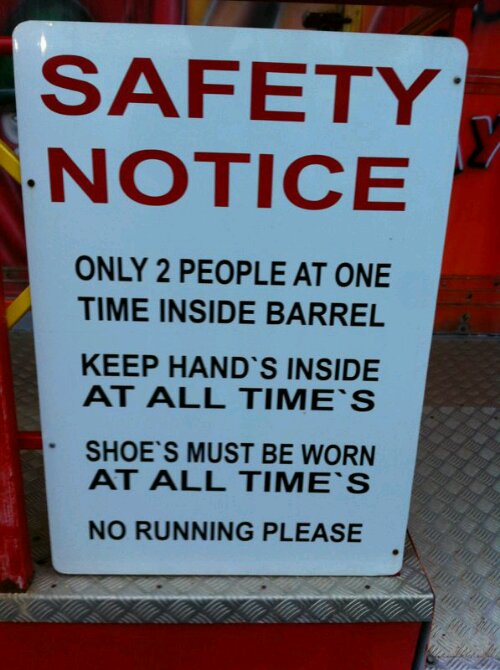
Apart from the obvious danger of getting into a barrel, can you see the (4) mistakes in this one? Not too hard, eh? Easy to see how kids pick up the bad habits when they do their own writing.
By the way, did you know there is an Apostrophe Protection Society in the UK? It’s actually been featured in a prog on TV some years ago. Here is a quote from their site:
“We are aware of the way the English language is evolving during use, and do not intend any direct criticism of those who have made mistakes, but are just reminding all writers of English text, whether on notices or in documents of any type, of the correct usage of the apostrophe should you wish to put right mistakes you may have inadvertently made.”
Although I am not a member I do think they’re making a very valid point and if they don’t highlight the issue who else will? Check out the “Examples” tab on their site (www.apostrophe.org.uk) and look at some of the howlers – including stuff written by teachers!
Back to the pics. Well, clearly I was on a roll. I’d been going for only 10 mins and had two signs bagged already. I could see another one on a fence in the distance so ran over to see what it said:
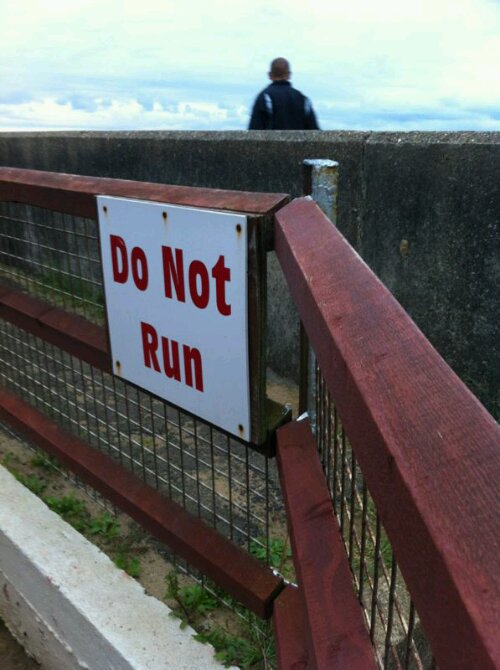
Doh! No mistakes and after me eagerly running all the way over.
Then further along the Promenade was this one:
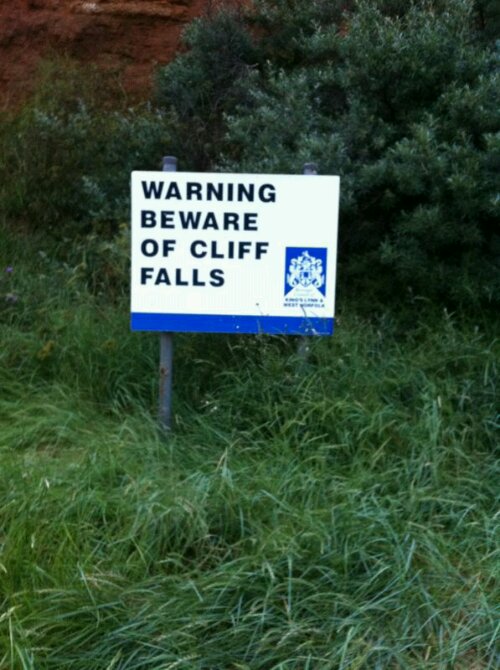
Now I know some people might say you should beware of Cliff Richard but after asking the locals it seems no-one knew who this Cliff Falls guy was. Anyway we had a lovely walk along the beach under the overhanging red rocks and we waved back at all the people who were shouting and waving at us from over on the promenade. We couldn’t tell what they were saying but we thought - this seems to be a really friendly town.
A couple of days later I was in a Craft Centre and came across this one:
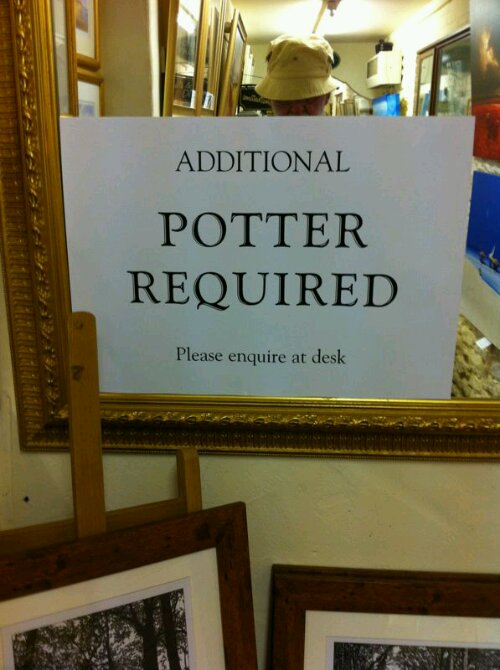
Pointing to the sign, I suggested to the Craft Centre lady that perhaps Harry could help. She was not amused. Oh well…
However, was wondering if LLM might want to apply. Why? Well, it seems she might be good at it. If you read her blogs regularly you will have come across the following examples (there are more):
31.7.12 – An Admission - “I pottered over, friendly mission face on….”
27.7.12 – I came, I saw, I passed – “After work, I pottered off home….”
20.7.12 – To Aslan’s Mountain with a wisdom stick – “As we pottered along, admiring the views….”
13.7.12 – Searching For Agatha – “…and potter about in the countryside for a while.”
I like that expression “to potter” or “potter about”. It gives a real sense of relaxed meandering; while others frantically push and shove or drive manically you are in no rush, plenty of time to look around and take in the landscape (or townscape). It speaks of a detached air, of being happy in oneself, unconcerned with the normal daily grind. Yes, pottering about is good. I must have a go at it.
Just across the road was this:
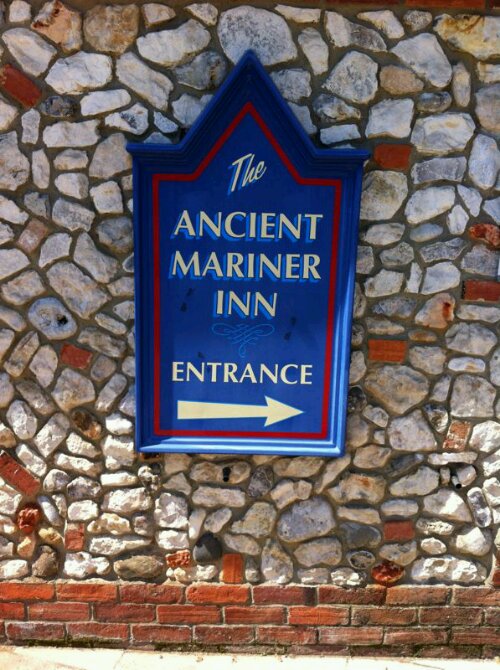
You know what happened? I went in and…… that’s right, there were no ancient mariners! Fancy having a pub just for ancient mariners. I reckon they’re probably a dying breed! (By the way the verse at the start of this post, if you hadn’t guessed, is from Coleridge’s The Rime Of The Ancient Mariner.)
On the Sunday, we went to a Flower Festival in a nearby village. At the entrance to the church we saw this sign:
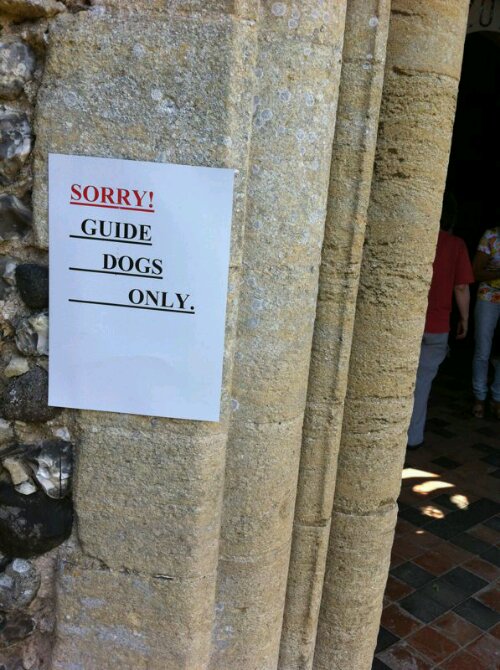
Yep, you’ve guessed it…….. inside there were no guide dogs….. just loads of people!
There were a number of historical displays inside. This one was about the Norman Conquest. I approached with caution believing it might be one of those things which when people get close it suddenly jumps out at you (and shouts something scary) because there’s a real human being inside who was just keeping very still. There wasn’t……so it didn’t. (I suppose if a person had had an arrow stuck in his eye it would have been quite hard to stand still):
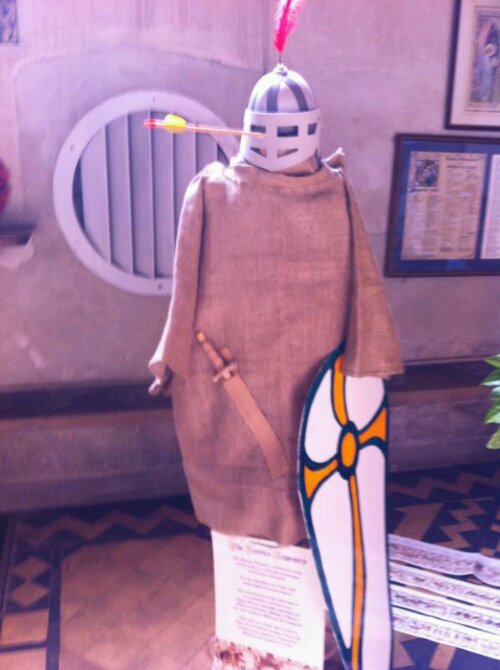
Now apparently the idea that King Harold II (Harold Godwinson) was killed (1066) by an arrow in the eye comes from the pictures on the famous Bayeux Tapestry. However, it also shows what some believe to be another figure also representing Harold being killed by a sword. So it might have been arrow, might have been sword or could have been both.
Another display sign was this one:
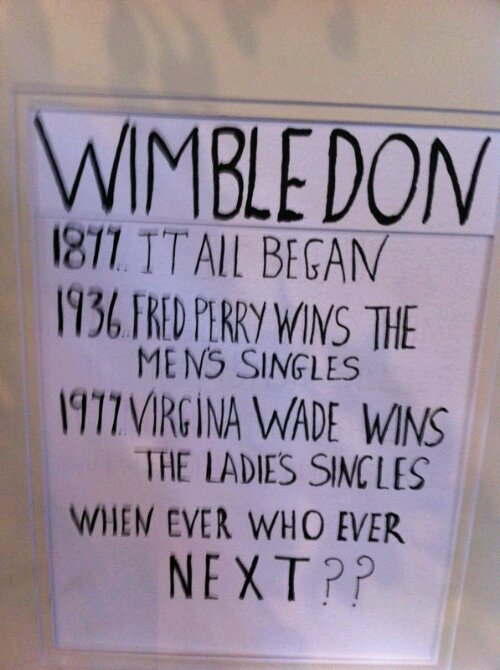
Can you spot the mistakes this time? (I count three. Did you get them all?)
Towards the refreshment area and other stalls was this one:

Just one this time. (Apologies to American readers who, I know, do spell it this way).
On Tuesday we went on the Wells to Walsingham Light Railway. The sign told me this amazing fact:
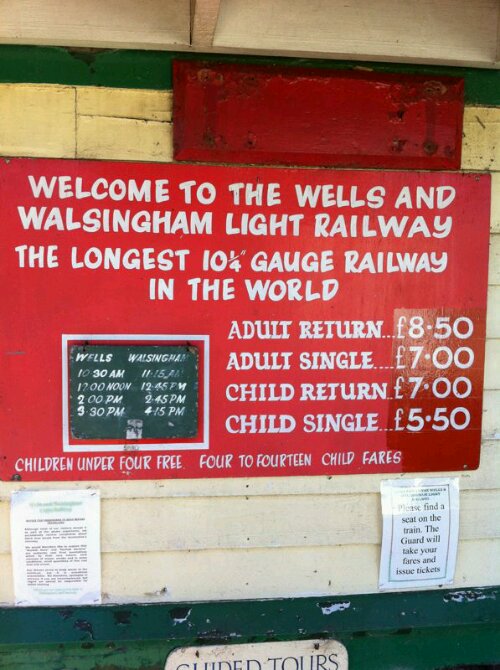
I was impressed – the longest 10¼” gauge in the world! Where did the idea for that width come from? You might think it must be one of those Victorian oddities from long ago but surprisingly this one was built only very recently (1982). You probably won’t be surprised to know that there is actually a Ten and a Quarter Inch Gauge Railway Society and there is a website if you’re really interested.
Thanks to the Wells & Walsingham Light Railway for permission to use the following two photos from their website (as mine didn’t really come out that well).
We travelled on the blue engine. It was called the Norfolk Hero (began in service in 1987 & named in honour of Admiral Lord (Horatio) Nelson. He was born in 1758 in Burnham Thorpe, just 5½ miles west of where the railway starts & 9½ miles east of the village where I stayed):
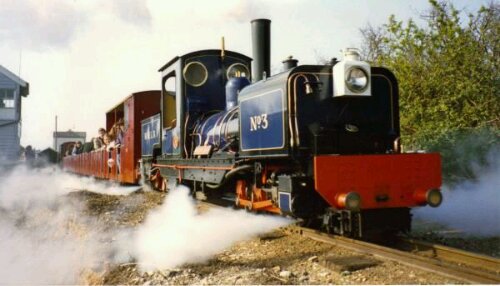
There is a second engine (new in 2011) called Norfolk Heroine. It is named in honour of Edith Cavell, a British nurse who worked in Belgium during WW1, born 1865 in Swardeston near Norwich in Norfolk. She was shot, in Oct 1915, by the occupying German forces, for helping prisoners escape.
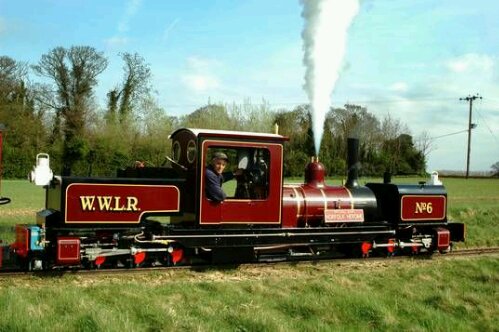
Also nearby was the following warning sign:
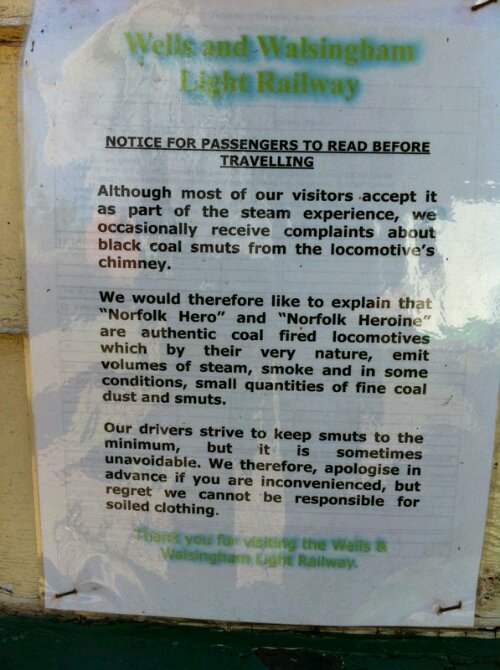
You might have to enlarge it but it’s typical of the signs organisations like this have to put up because of the (blame and) claim culture which infects everything these days. It’s a steam train, it runs on coal, it puffs out smoke – what do people expect? However what I didn’t expect was to get hit by one of “the smuts” in a very painful place. Just 15 mins into the journey I suddenly found myself blinking like mad as a piece of smut (prob coal dust) blew into my eye causing me to rub like mad to try and get it to the corner where I thought it wouldn’t hurt as much. Apart from that it was a really enjoyable day out on the little train.
Here’s another ‘spot the mistake one’:
Easy that one? Hope the art was going to be better than the spelling. (I wouldn’t still be there to find out though.)
I like this one because it’s a good pun-like trade name:
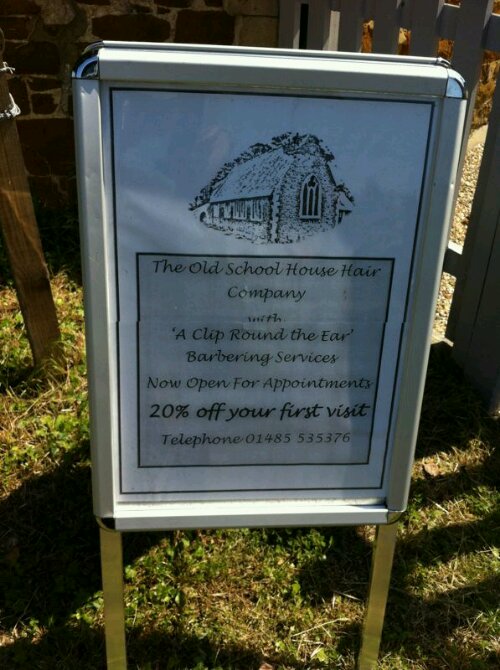
Check out the barber’s name in line 4. Hair salons and barber often do call themselves distinctive names. An unusual one I remember from some years ago was called - “Curl up and Dye”.
I’ll finish with one from the main road in the village where I was staying:

It gave me a good laugh anyway. Again you’ll need to enlarge it to see the small text but noteworthy bits are: the price – one quacker, published by – Eggsactly Newspapers and the motto (top right) – “Out for a duck, not run down”. And there are two of them near to the pond. What wags these local rustics are, eh?
I’ve decided - I like signs, especially when sometimes they DON’T say what they mean, sometimes when they’re just fun to read and sometimes when your response is tongue-in-cheek. I didn’t intend to take pics like this but, after the initial spots on day 1, looking for more just became routine. You’re probably asking yourself what assignment was he on about at the beginning of this post? He’s not mentioned it at all. Can you see it now? What assignment? (Do you see what I did there? What a sign meant - haha).
No comments:
Post a Comment